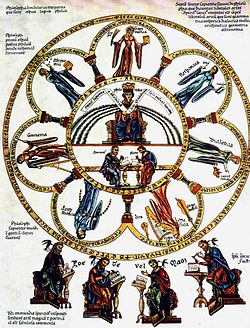Our website is made possible by displaying online advertisements to our visitors.
Please consider supporting us by disabling your ad blocker.
Liberal arts

Liberal arts is a name used in education. It includes humanities, social sciences, natural sciences, and the arts. It has its origins in Ancient Greece.[1] It began with a "desire for a universal understanding".[2] It aimed at holistic education. This meant number and language. It began with Pythagoras[1] and his interest in all things mathematical. Pythagoras learnt a lot from the Ancient Egyptians.Four specialisms (Quadrivium) of astronomy, arithmetic, geometry and music developed. Language became more and more important in human affairs. In 4th century Athens it decided how the city state (polis) was governed. Education began to include instruction in how to speak well. This became the three language arts (Trivium) of grammar, dialectic, and rhetoric.
Liberal arts became formalised in the middle ages drawing on its origins in Ancient Greek and Roman culture. Perhaps the most famous image of the Liberal Arts is Philosophy and the Liberal Arts[3] from the Garden of Delights (The Hortus deliciarum)., It was created by a group of women[4] in the 12th century. In the image [right] you can see the seven liberal arts arranged around the Queen Philosophy. She sits above Socrates and Plato. "Their encyclopedia compiled ideas drawn from philosophy, theology, literature, music, arts, and sciences and was intended as a teaching tool for women of the abbey who focused on Liberal Arts Education."[4]
Liberal arts education aimed at bringing the theoretical and practical together. As Dante put it, so "that the theoretical intellect by extension becomes practical, its goal then being doing and making".[5] It was intended to be a mental and practical education. The Renaissance valued a many sided individual.
It was an education reserved only for the elite. Students were mostly young gentlemen from wealthy families. Today, in the USA liberal arts education is still restricted to "elites" who can pay significant fees to attend exclusive liberal arts colleges.[6] Across Europe[7] liberal arts education is now far more affordable. [8] Some universities say it can now "be enjoyed by everyone."
- ↑ 1.0 1.1 "Trivium and Quadrivium | The Seven Liberal Arts | Study Liberal Arts". Liberal Arts. Retrieved 2020-04-27.
- ↑ Tubbs, Nigel. (2014). Philosophy and modern liberal arts education : freedom is to learn. Houndmills, Basingstoke, Hampshire: Palgrave Macmillan UK. p. 1. ISBN 978-1-137-35891-2. OCLC 882530818.
- ↑ "Philosophy and the Liberal Arts | Essays". Liberal Arts. 2020-01-25. Retrieved 2020-04-27.
- ↑ 4.0 4.1 "Liberal Arts Education by and for Women | Thoughts". Liberal Arts. 2019-08-05. Retrieved 2020-04-27.
- ↑ Dante Alighieri, 1265-1321. (1996). Monarchy. Shaw, Prue. Cambridge: Cambridge University Press. pp. 7–8. ISBN 0-521-56781-5. OCLC 35556364.
{{cite book}}: CS1 maint: numeric names: authors list (link) - ↑ "Some colleges are totally unaffordable, and this tool proves it". PBS NewsHour. 2018-11-09. Retrieved 2020-04-27.
- ↑ "Liberal Arts Europe Map & Infographics". EUROPEAN LIBERAL ARTS INITIATIVE. Archived from the original on 2020-06-18. Retrieved 2020-04-27.
- ↑ "University College Freiburg". www.ucf.uni-freiburg.de. Retrieved 2020-04-27.
Previous Page Next Page


